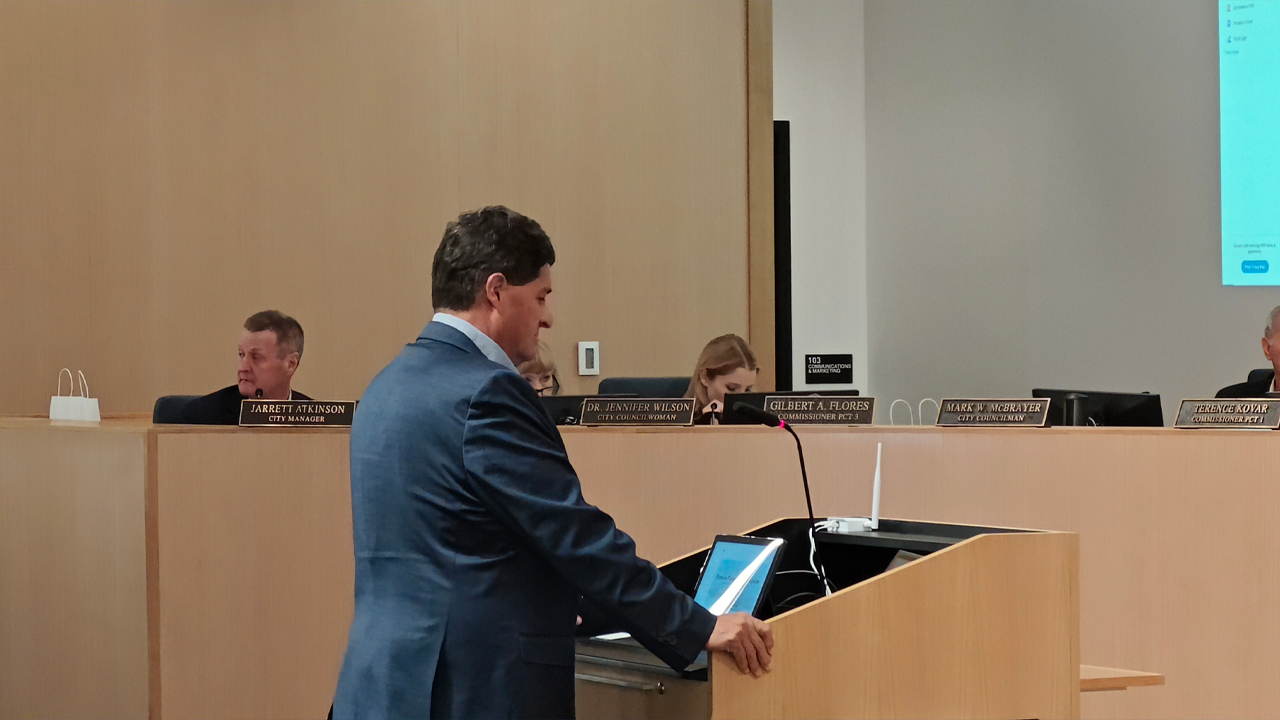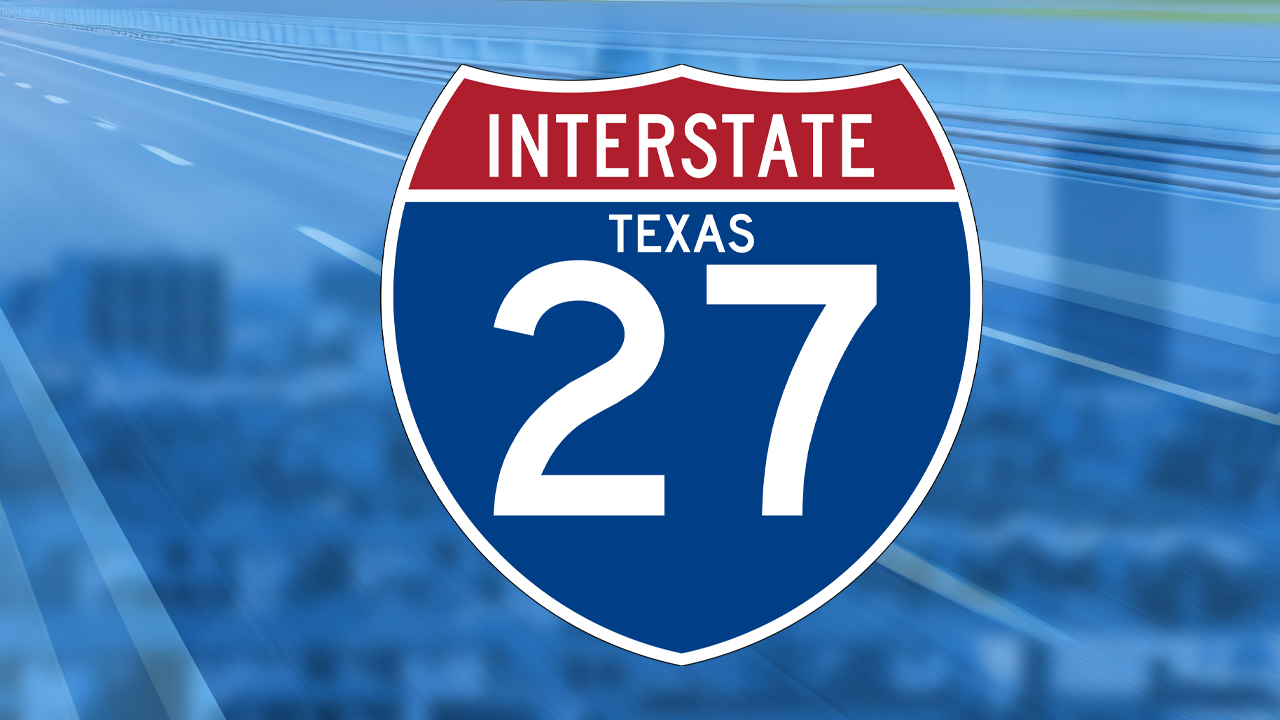Interstate 27 highway shield in the foreground with a combination AI generated image of a futuristic highway and the Lubbock skyline in the background.
The trip from Laredo to Dalhart is roughly 700 miles. The best EVs (electric vehicles) won’t make it. You’ll get as far as San Angelo before the battery dies.
Let’s change the rules.
You’re driving that same stretch, but your car battery doesn’t care if it’s 700 miles or a million.
The road itself will be a charging station for your EV. It will have built-in internet, lanes for driverless vehicles, drone landing zones, collision alert systems and some other bells and whistles.
This is the vision for a brand-new Interstate 27 to run from Laredo, Texas to the northwestern edge of the Panhandle and beyond – along with reducing traffic deaths.
Products will be cheaper because travel times will be shorter, and just maybe Interstate 35, with a little help from I-27, will no longer be the great Texas bottleneck.
But there’s work to be done. The shiny new highway of the future will be a potential target for hackers, computer viruses and the like.
Why it matters
“We’ve got to design this corridor for the future,” said Lauren Garduno, president and CEO of Ports to Plains – the Lubbock-based organization lobbying for a highway system from Mexico to Canada.
For every dollar the Texas Department of Transportation spends on highways, it puts more than $2 back into the economy, according to Garduno.

The Ports to Plains Corridor will bring more than 22,000 new jobs, $2.84 billion in products manufactured along the route (GDP) and $4.1 billion in travel savings. That’s just for Texas.
Dr. Hongchao Liu, a Texas Tech professor, said, “Traffic congestion cost about $115 billion for U.S. drivers in 2021.”
Ports to Plains, when complete, will connect $12 billion of the nation’s cattle industry. And, by going through Lubbock it will connect 40 percent of the nation’s cotton industry.
Perhaps most important; Garduno, Liu and others share a goal of zero highway deaths by the year 2050. The federal government says more than 40,000 people die every year in crashes in the United States. The new I-27 could help with that.
Where is the money for this?
Texas voters in 2014 approved two measures to more than double the state’s road money. Instead of choosing between road repair, congestion relief in big cities, or new routes, now TxDOT can do all three.
The state has a Unified Transportation Program, which, in 2016, went from $35 billion to $75 billion over ten years. Garduno said it’s now closer to $100 billion every 10 years.
The Ports to Plains group needs to get roughly $2.4 billion per year to complete the Texas portion of the route in 10 years. So far, funding has been more on pace for 20 years.
Garduno thinks the southern portion in Texas really will be done in 10 years because Congress and the state legislature made it a priority.
Congress recently designated I-27 all the way from Laredo to an intersection with Interstate 25 at Raton, New Mexico.
Currently I-27 is 124 miles. The Texas portion will be more than 930 miles when finished. That includes I-27E and an I-27W to run the new route through both Big Spring and Midland plus an I-27 N from Dumas to the Oklahoma border.
Not your granny’s interstate
The road itself will be part of the internet.
“There’s a lot of money in the Federal Highway bill for that kind of technology,” Garduno said.
Liu said, “Vehicles can communicate with each other, and vehicles can communicate with the infrastructure. For example, if there is a major accident somewhere, let’s say two or three miles ahead, then you’ll be receiving the information.”
“Drivers will be guided to take another road so that they won’t be jammed in the congestion,” Liu said.
The pavement can detect crashes and automatically notify emergency responders.
Trucks can weigh without stopping and cargo can be inspected through the U.S. Mexico border without ever stopping, Garduno said.
“Also, water and electricity – at some point there, you need to put the water in that corridor also,” Garduno said. “It could be pipeline transportation too.”
Garduno emphasized something called VTAL – vertical takeoff and landing. Think of VTAL as a drone-port. That’s a big deal for rural healthcare, he said.
Trucks can get drones with emergency supplies to the VTAL location along the highway and launch them to a hospital.
A dangerous problem and a practical one
The high-tech roads of the future need sensors, communication, advanced computing and security. Liu specializes in smart transportation systems and more specifically the sensors making it work.
“I would say that cybersecurity is the foremost and the most important thing to support the idea of autonomous vehicles and the smart highway system,” Liu said.
Liu points out if your computer gets hacked, that’s bad. If your self-driving car on a high-speed computerized highway gets hacked, that’s dangerous and maybe even deadly.
“That’s going to be a disaster,” Liu said.
Directing your car into a crash is one possible attack. Just making all the cars stop on the highway to block traffic is another.
Engineers and researchers are working on it, he said. Some of these futuristic features cannot happen until the cybersecurity is ready.
It’s not enough to get people moving. They have to keep moving.
“If you have hundreds of thousands of vehicles passing on that road, it will create a lot of damage to the surface of the road. It could also damage the sensor underneath the road,” Liu said.
Again, this is another area that researchers and engineers are working on, he said. He thinks it will happen.
Not a wall, but kind of like one
“We have about 125 miles of our corridor that runs on the border,” Garduno said. “There’s always this big issue about border security and how to secure it.”
A limited-access interstate with access roads on each side is more than 400 feet wide.
“You have a 400-foot opportunity to place all kinds of technology in that corridor for security,” he said. For some in the Congress and Texas Legislature, that’s a selling point.
“I would call it a natural barrier,” Garduno said.
A Tech graduate driving the change
Garduno remembers the days when Interstate 27 from Lubbock to Amarillo was under construction. He was headed from Borger to Lubbock to attend school at Texas Tech.
I-27 was four main-lanes plus an access road on each side. That’s it. The technology was basically the pavement and the overpasses.
Having graduated from Tech with a degree in civil engineering, Garduno became a member of the Civil and Environmental Engineering Academy, worked for the Texas Department of Transportation twice and retired twice.
“The joke I keep telling my board is: I’m 60 years old today, and I’m willing to work on this for 10 years, and then I’m gonna be tired. I’m gonna be done. So, we gotta get this Interstate built in 10 years,” Garduno said.
“I’m hoping that I can engage Texas Tech University to be a part of that,” Garduno said.
But that’s not the only university.
The University of Texas at Austin has something called the Center for Transportation Research. Garduno said the center tests autonomous vehicle technology and something called the Smart Freight Corridor on State Highway 130 – billed as the fastest way between San Antonio and Austin.
“We’ve asked them to consider using I-27 footprint as a role model when it comes time for them to expand that into the rural area.”
Comment, react or share on our Facebook page.


 Facebook
Facebook